Pygocentrus nattereri
Red Bellied Piranha
SynonymsTop ↑
Pygocentrus altus Gill, 1870; Serrasalmo ternetzi Steindachner, 1908
Etymology
Pygocentrus: from the Ancient Greek πῡγή (pūgḗ), meaning ‘rump’, and κέντρον (kéntron), meaning ‘sharp point, thorn, spine’, in reference to the serrated abdomen in genus members.
nattereri: named for Austrian naturalist Johann Natterer (1787-1843).
Classification
Order: Characiformes Family: Serrasalmidae
Distribution
Currently accepted to occur throughout much of the Amazon basin (Brazil, Ecuador, Peru, Bolivia, and questionably Colombia), as well as the Río Essequibo (Guyana and Venezuela), some smaller, coastal drainages in north-east Brazil/the Guianas, and further south in the Río Paraná (Brazil, Paraguay, and Argentina) and Río Uruguay (Brazil, Uruguay, and Argentina).
Type locality is ‘Cuiabá and Mato Grosso, Brazil’.
Habitat
Found in most habitat-types across its range including major river channels, smaller tributaries, oxbows, floodplain lakes, and artificial lakes formed by dams.
Maximum Standard Length
250 – 350 mm.
Aquarium SizeTop ↑
Suitable only for public installations or the very largest private aquaria.
Maintenance
Some aquarists maintain this species in bare-bottomed arrangements for ease of maintenance, but standard aquarium gravel or sand are both suitable substrates. Other décor is basically down to personal taste but plants may be eaten, especially if the fish decide to spawn. Lighting is relatively unimportant and can be dim to strong as preferred.
Pygocentrus spp. typically produce a lot of waste so the use of one or more over-sized external filter is essential. If possible buy units with inbuilt heaters or at least fit a sturdy heater-guard as adults have been known to damage submerged equipment. Sump systems also work well in this respect.
Aim to change 30-50% of the tank volume each week, and exercise extreme care when performing such maintenance or netting the fish for any reason.
Water Conditions
Temperature: 24 – 28 °C
pH: 5.5 – 7.5
Hardness: 36 – 215 ppm
Diet
Pygocentrus spp. are not exclusive carnivores and are more accurately described as opportunistic generalists.
The natural diet consists of live fishes plus aquatic invertebrates, insects, nuts, seeds, and fruits. Each jaw contains a single row of sharp, pointed, triangular teeth, which are used like blades to puncture, tear, chop, and crush.
They sometimes attack sick or dying fishes, scavenge carcasses, or bite chunks from the fins of larger species, but assaults on live animals entering the water are very rare and mostly relate to accidental biting or cases in which numbers of fish have become trapped in small pools during dry periods.
In the aquarium juveniles can be offered chironomid larvae (bloodworm), small earthworms, chopped prawn, and suchlike, while adults will accept strips of fish flesh, whole prawns, mussels, live river shrimp, larger earthworms, etc.
This species should not be fed mammalian or avian meat since some of the lipids contained in these cannot be properly metabolised by the fish and may cause excess fat deposits and even organ degeneration. Similarly, there is no benefit in the use of ‘feeder’ fish such as livebearers or small goldfish, which carry with them the risk of parasite or disease introduction and tend not have a high nutritional value unless properly conditioned beforehand.
Behaviour and CompatibilityTop ↑
Best-maintained alone, although adults do not tend to prey on much smaller fishes.
It is often said that wild P. nattereri hunt in voracious packs, but usually only juveniles form aggregations. Older individuals exist in loose groups and form dominance hierarchies, therefore the purchase of either a single specimen or group of 5+ is recommended, with the latter preferable.
Sexual Dimorphism
Females generally attain a larger adult size and exhibit a more-rounded body shape than males.
Reproduction
Wild populations exhibit two annual reproductive seasons, the first during the rising of the water level at the onset of the wet season, and the second during the low water period during November and December, when there is a sudden temporary increase in water level. Flooded marginal vegetation and marginal grasses within floodplain lakes are the preferred spawning areas.
P. nattereri is relatively easily to breed in the aquarium. Sexual maturity is reached at around a year of age and 100-150 mm TL. Unless you can find a sexed pair it is perhaps best to begin with a group of 6+ individuals, allowing pairs to form naturally. In some documented cases spawning has been initiated by large, cool water changes, whereas in others it occurred without intervention.
As males come into breeding condition they begin to become territorial, mouth and caudal-fin to create a pit in the substrate at the centre of their chosen site. Aquatic plants may also be cropped, and the resultant ‘nest’ is defended against other males.
Receptive females demonstrate interest by mouthing the substrate around the nest, and both male and female now display a darker body colouration. Eggs and spawn are deposited in several batches and guarded by the male, sometimes assisted by the female. In very large aquaria multiple pairs can spawn simultaneously.
The eggs hatch in 2-3 days with fry free-swimming by the fifth. At this point it is considered best practice to siphon them into smaller, sponge-filtered, set-ups. Several meals of Artemia nauplii, microworm, or equivalent, and water changes of ~10% tank volume are required daily.
The fry become increasingly cannibalistic as they grow so should be moved to progressively larger aquaria in batches of similarly-sized individuals. Think carefully before taking on such a project, however, as you could end up with 1000+ young fish with very little sell-on value.
NotesTop ↑
Famed as a rapacious predator capable of rapidly stripping flesh from bone and a danger to any animal entering its native waters, P. nattereri is among the most notorious freshwater fishes in the world. As a result, displays featuring this “bloodthirsty” creature are found in most public aquaria, grisly Hollywood movies have been released, and the species has become popular in the aquarium trade.
According to Herbert Axelrod (1976), the myth began when American president Theodore Roosevelt made a visit to Amazonian Brazil in 1913. He was accompanied by many journalists and the Brazilians organised a number of publicity stunts, one of which was that the president would ‘discover’ a river which would then be named after him. A tributary of the Río Aripuanã previously known as the Río da Dúvida (River of Doubt) was chosen, and it is still referred to as the Río Roosevelt or Río Teodoro today.
When Roosevelt arrived at the river the Brazilians had a surprise prepared; a stretch of several hundred yards had been netted off and for a number of weeks fishermen had been catching hundreds of adult piranhas and isolating them there. They told the president that he and his men should refrain from entering the water as they would be eaten alive by vicious fish. Naturally this news was met with scepticism, so a cow, variously quoted as being “sick”, “old” and “in season” was introduced. Some even say that its udders had been sliced open. This caused a spectacular feeding frenzy among the trapped, starving piranhas, and newspapers were filled with stories of terrifying, flesh-eating fishes, yet there remains not a single record of wild piranhas killing a human being.
Informed captive maintenance of piranhas and their relatives has undergone a relative boom over the last decades, with a number of websites and forums now dedicated to the subject. Many different species are available, but the majority are wild caught, costly, and beyond the means of most hobbyists. P. nattereri is farmed in commercial quantities, however, with coin-sized juveniles sold rather cheaply for a fish requiring specialised and ultimately expensive care. For the enthusiast it makes an excellent aquarium subject, but considerable thought and research are essential prior to purchase.
In terms of the genus Pygocentrus, most modern workers continue to follow the nomenclatural system proposed by Fink (1993) in which there exist three species; Pygocentrus piraya (Cuvier, 1819), P. cariba (Humboldt, 1821), and P. nattereri. While the identities of the first two remain in little doubt, Fink was unable to accurately diagnose P. nattereri, and it remains uncertain whether the species represents a single evolutionary lineage or not. P. palometa Valenciennes 1850 was described from the Río Orinoco, is still listed as valid by some sources, and occasionally appears on trade lists, but is generally regarded as a nomen dubium.
Following Fink (1993), P. nattereri can be distinguished from congeners by the following combination of characters: adipose fin always without rays (vs. large specimens with adipose rays in P. piraya); humeral spot always small or entirely absent (vs. large in specimens > 100 mm SL in P. cariba); body often with numerous spots (vs. few in P. cariba specimens > 100 mm SL); branched dorsal-fin rays 14-18, usually 15 (vs. 15-18, usually 16, in P. piraya); usually 6 neural spines anterior to first pterygiophore (vs. usually 7 in P. piraya); vertebrae 35-38, usually 36 (vs. 36-39, usually 38 in P. piraya); usually 5 supraneurals (vs. usually 4 in P. cariba).
P. nattereri has proven difficult to identify for a number of reasons. For example, P. piraya and P. cariba are endemic to single river basins (the Río São Francisco in Brazil and Río Orinoco in Venezuela/Colombia, respectively) and possess distinct morphology. P. nattereri, however, has an incredibly wide distribution, and colour pattern can vary considerably even between individuals of a single population. Colour pattern is also known to vary with habitat-type; fish inhabiting blackwater environments tend to be darker with less red/orange than those from clear or white waters.
Morphology and patterning in adults can vary in terms of head and body shape, presence or absence of dark spots, or reticulated markings on the flanks and fins.
Such differences have led to some populations being described as distinct species, most notably P. altus Gill, 1870 from the Upper Amazon and P. ternetzi Steindachner 1908 from the Río Paraguay. Although piranhas continue to be traded under both names, Fink (1993) studied over 100 specimens from different parts of the Amazon and Río Paraguay drainages and was unable to find any consistent character (shape, colour pattern, meristic counts) that could be used to define them according to origin. Having found all three species non-diagnosable he decided to synonymise P. altus and P. ternetzi, with P. nattereri remaining valid since it is the oldest available name.
Though he admitted himself it was an unsatisfactory option, Fink’s classification is still in place today. In a later study (Fink & Zelditch, 1997) differences in body form between ‘northern’ and ‘southern’ populations of P. nattereri were observed, but evidence that they represent different species was still considered insufficient.
The family Serrasalmidae contains 16 genera comprising the piranhas, pacus and relatives. Their characteristic features include a compressed body shape, long dorsal fin with 16 or more rays, and a variable number of sharp serrae formed by modified abdominal scales on the ventral surface. They are found in numerous habitat-types, from lowland floodplains and flooded forests to upstream headwaters, and occur in all major South American river systems east of the Andes. Some species perform unique ecological functions such as seed dispersal, or sustain important inland fisheries and aquaculture projects.
Members display three main feeding habits: carnivory (flesh-eating), frugivory (fruit and seed-eating), and lepidophagy (eating the scales and fins of other fishes). Carnivorous species normally possess a single row of tricuspid teeth on each jaw, frugivores tend to have two series of incisor or molariform teeth on the premaxilla, one row of teeth on the dentaries and often a pair of symphyseal teeth, while in lepidophages the teeth are tuberculate and located on the outer edge of the premaxilla.
The evolutionary history of serrasalmids has been studied by various authors, with the most recent analyses (Thompson et al., 2014) supporting the existence of three major clades within the family. The “pacu” clade contains the genera Colossoma, Mylossoma and Piaractus, the “true piranha” clade includes Metynnis, Pygopristis, Pygocentrus, Pristobrycon, Catoprion, and Serrasalmus, and the Myleus clade comprises the Myleus-like pacus.
References
- Kner, R., 1858 - Mathematisch-Naturwissenschaftliche Classe 32(22): 163-168
Zur Familie der Characinen. Sitzungsberichte der Kaiserlichen Akademie der Wissenschaften. - Anderson, J. T., T, Nuttle, J. S. Saldaña Rojas, T. H. Pendergast and A. S. Flecker, 2009 - Proceedings of the Royal Society of London B: Biological Sciences 278(1723): 3329-3335
Extremely long-distance seed dispersal by an overfished Amazonian frugivore. - Axelrod, H. R., 1976 - TFH Publications, Inc. Neptune City, NJ: 79-87
Breeding Aquarium Fishes. - Duponchelle, F., F. Lino, N. Hubert, J. Panfili, J-F. Renno, E. Baras, J. P. Torrico, R. Dugue and J. Nuñez, 2007 - Journal of Fish Biology 71(4): 1113-1134
Environment-related life-history trait variations of the red-bellied piranha Pygocentrus nattereri in two river basins of the Bolivian Amazon. - Ferreira, F. S., W. Vicentin, F. E. dos Santos Costa and Y. R. Súarez, 2014 - Acta Limnologica Brasiliensia 26(4): 381-391
Trophic ecology of two piranha species, Pygocentrus nattereri and Serrasalmus marginatus (Characiformes, Characidae), in the floodplain of the Negro River, Pantana. - Fink, W. L., 1993 - Copeia 1993(3): 665-687
Revision of the piranha genus Pygocentrus (Teleostei, Characiformes). - Fink, W. L. and M. L. Zelditch, 1997 - Copeia 1997(1): 179-182
Shape analysis and taxonomic status of Pygocentrus piranhas (Ostariophysi, Characiformes) from the Paraguay and Paraná River basins of South America. - Freeman, B., L. G. Nico, M. Osentoski, H. L. Jelks and T. M. Collins, 2007 - Zootaxa 1484: 1-38
Molecular systematics of Serrasalmidae: Deciphering the identities of piranha species and unraveling their evolutionary histories. - Hubert, N., F. Duponchelle, J. Nunez, C. Garcia-Davila, D. Paugy, and J. F. Renno, 2007 - Molecular Ecology 16(10): 2115-2136
Phylogeography of the piranha genera Serrasalmus and Pygocentrus: implications for the diversification of the Neotropical ichthyofauna. - Ortí, G., A. Sivasundar, K. Dietz, and M. Jégu, 2008 - Genetics and Molecular Biology 31(1): 343-351
Phylogeny of the Serrasalmidae (Characiformes) based on mitochondrial DNA sequences. - Queiroz, H. L., M. B. Sobanski and A. E. Magurran, 2010 - Environmental Biology of Fishes 89(1): 11-19
Reproductive strategies of Red-bellied Piranha (Pygocentrus nattereri Kner, 1858) in the white waters of the Mamirauá flooded forest, central Brazilian Amazon. - Reis, R. E., S. O. Kullander and C. J. Ferraris, Jr. (eds), 2003 - EDIPUCRS, Porto Alegre: i-xi + 1-729
Check list of the freshwater fishes of South and Central America. CLOFFSCA. - Thompson, A. W., R. Betancur-R., H. López-Fernández and G. Ortí, 2014 - Molecular Phylogenetics and Evolution 81: 242-257
A time-calibrated, multi-locus phylogeny of piranhas and pacus (Characiformes: Serrasalmidae) and a comparison of species tree methods. - Vicentin, W., F. E. dos Santos Costa and Y. R. Súarez, 2012 - Environmental Biology of Fishes 96(1): 57-66
Population ecology of Red-bellied Piranha Pygocentrus nattereri Kner, 1858 (Characidae: Serrasalminae) in the Negro River, Pantanal, Brazil.



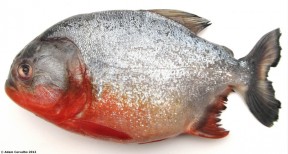
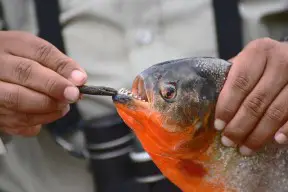

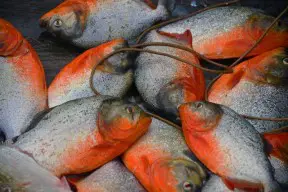

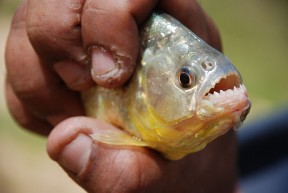
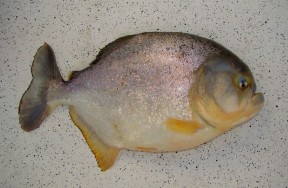
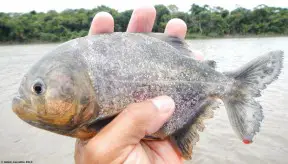
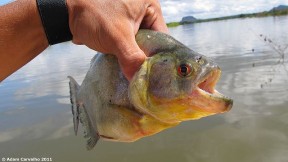
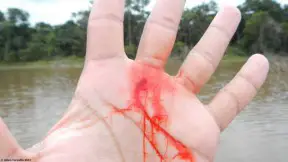


May 17th, 2012 at 6:53 am
Heiko Bleher wrote on facebook:
“This is the real Pygocentrus nattereri, from the type locality: upper Rio Guapore, Mato Grosso, Brazil. This species has almost never been seen in the aquarium hobby, and much less in public aquaria. Almost all Piranhas in aquaria named as P. nattereri are in fact Pygocentrus altus … — with Pablo Matias Viera Lind.” ?
May 17th, 2012 at 9:06 am
Hi Bojan only part of the P. nattereri type series came from the rio Guaporé, the rest came from Cuaibá which is upper rio Paraguay I think?
As far as I understand it the last revision of the group was by Fink (1993) and he found P. altus (upper Amazon) to be non-diagnosable from both P. nattereri (rio Cuaibá and rio Guaporé) and P. ternetzi (rio Paraguay) when specimens from across all three species’ ranges were compared, thus the other two were synonymised with P. nattereri as it was the first to be described.
Also from Fink’s paper: ‘The extent and color of the belly pigmentation is variable ontogenetically, individually,m geographically, and according to water conditions in which the fish live’.
May 22nd, 2012 at 1:43 pm
Heiko Bleher wrote today on that topic:
Géry never agreed with Fink, specially not lately. Unfortunately he could not see my recent work/published paper on this group (in the two recent PFK issues) – (nattereri – the true one almost no one has ever seen, nor is it in the hobby – stay smaller, much smaller).
See PFK April and Spring issues 2012 for more details of all species – discribed and undescribed.
May 25th, 2012 at 9:31 am
Heiko might be right, but those magazine articles surely don’t represent a review of the genus?
December 7th, 2013 at 4:24 pm
Speaking the suitable tank size for Serrasalmus nattereri written above, I strongly disagree. Because of the size and shooling behaviour (this fish feels best if kept in groups at least 5-6, better 10 specimens), besides it’s messy fish, all things considered the MINIMUM TANK SIZE should be AT LEAST 150 cm FOR ONE SPECIMEN.